TNT Sports brings sophistication, new energy in Roland Garros debut
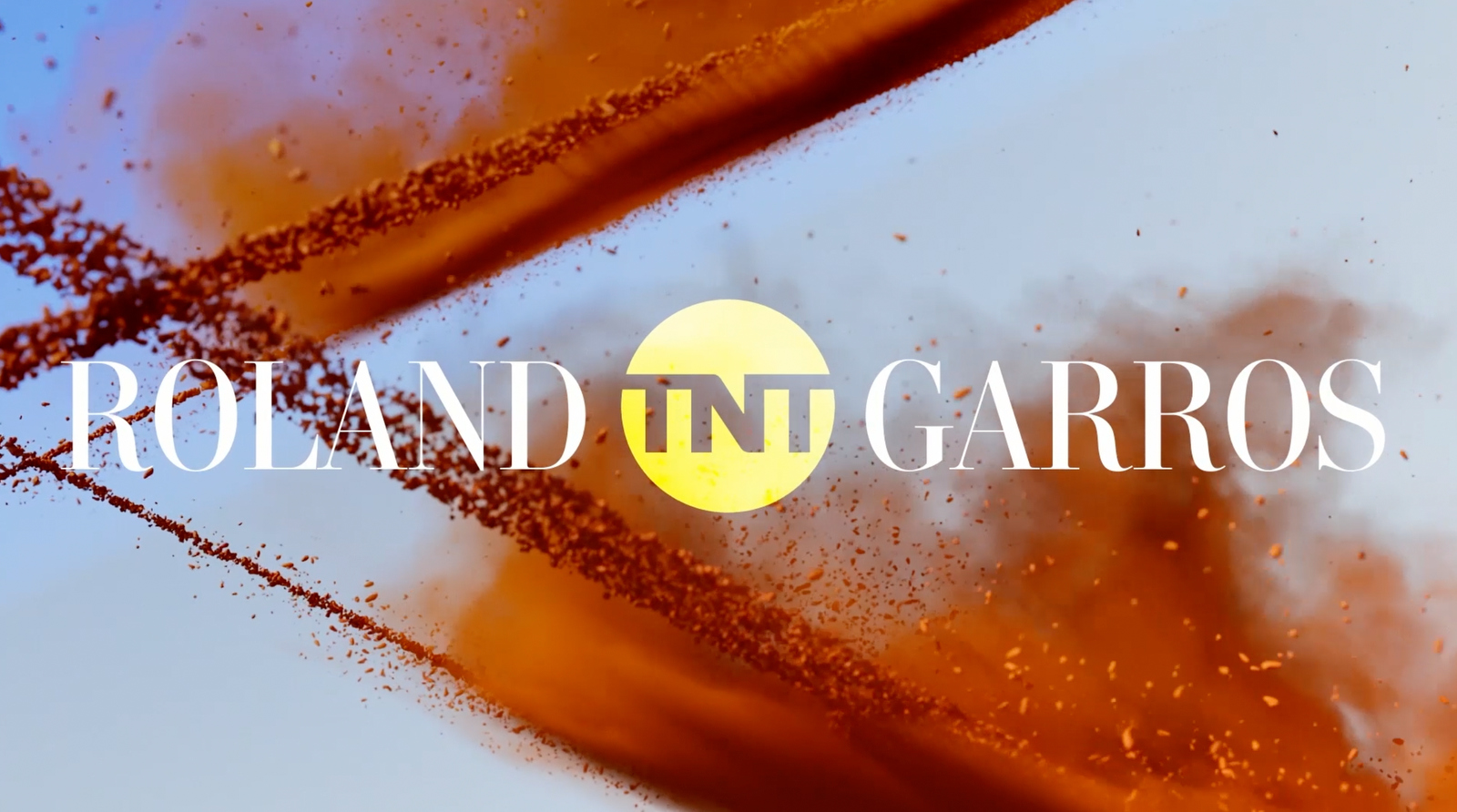
Subscribe to NCS for the latest news, project case studies and product announcements in broadcast technology, creative design and engineering delivered to your inbox.
TNT Sports arrived at Roland Garros this spring with an ambitious mandate, establish credibility in tennis broadcasting from day one. The network’s solution involved three flypack control rooms, 300 hours of planned coverage and a production operation that attempts to balance innovation with respect for tennis tradition.
“This being our first Roland Garros event, we’re throwing everything at it,” said Jordan Shorthouse, VP and creative director, noting the effort to bring innovation and new technology to tennis coverage.
The extensive coverage marks the first year of TNT Sports’ decade-long media rights agreement with the Fédération Française de Tennis (FFT). The package includes full tournament coverage on TNT, qualifying rounds streamed on Max, and “The Rally at Roland-Garros,” a whiparound-style show on truTV hosted by John McEnroe and Mark Petchey.
The scale reflects both opportunity and challenge for TNT Sports as they navigate tennis broadcasting while managing concurrent sports commitments.
Engineering for the unexpected
Chris Brown, VP of production technology, built the technical operation around what he calls “ultimate flexibility.” The three flypack control rooms, constructed with partner EMG/Gravity Media, were designed to pivot instantly between traditional match coverage and weather-delay programming that proved essential during rain-interrupted early rounds.
“There was a desire to make sure that they were all flexible and capable of flexing into any type or style of coverage that was necessary,” Brown said, referring to everything from individual match coverage to truTV’s whiparound production.
The control rooms feature Grass Valley Kayenne K-Frame production switchers, Ross Video XPressions graphics and Calrec Artemis audio consoles, mimicking TNT’s Atlanta layout. EVS Cerebrum provides centralized operation control, while Warner Bros. Discovery’s media network, managed with Globecast, handles connectivity and transmission infrastructure.
“No matter how much we talk about it… we don’t know what we don’t know because we haven’t been through it,” Brown explained.
Camera innovation driven by space constraints
Roland Garros’ premium real estate on Court Philippe Chatrier and Court Suzanne Lenglen necessitated that TNT Sports adopt technological solutions to augment the pool of world feed cameras, deploying compact camera systems specifically designed to overcome the limitations.
“We recognized that space is of a premium on the two main courts,” said Steve Fiorello, VP and coordinating director. “So working with Chris and various vendors, we kind of knew that if we were gonna get cameras in those areas… we would have to come up with small footprints.”
The camera package includes Nucleus cameras positioned on service lines of both main courts, Panbar robotic cameras by NEP Specialty Capture that provide close-up shots without requiring on-site operators, and three RF cameras that enable reporters to roam among fans. Hawk-Eye technology and super-slow-motion camera setups complete the technical arsenal.
The Federation Francaise de Tennis initially expressed concerns about sight lines and spectator impact but approved the technology after seeing its minimal visual footprint. The result provides camera angles that distinguish TNT Sports’ coverage from the tournament’s world feed production managed by Whisper.
Studio design that brings the fan perspective
The studio occupies what Fiorello identified as Roland Garros’ equivalent to Wimbledon’s Henman Hill, the Plaza de Mesquitere. This positioning places TNT Sports’ coverage directly within the tournament’s primary fan gathering area, creating authentic atmosphere rather than artificial energy.
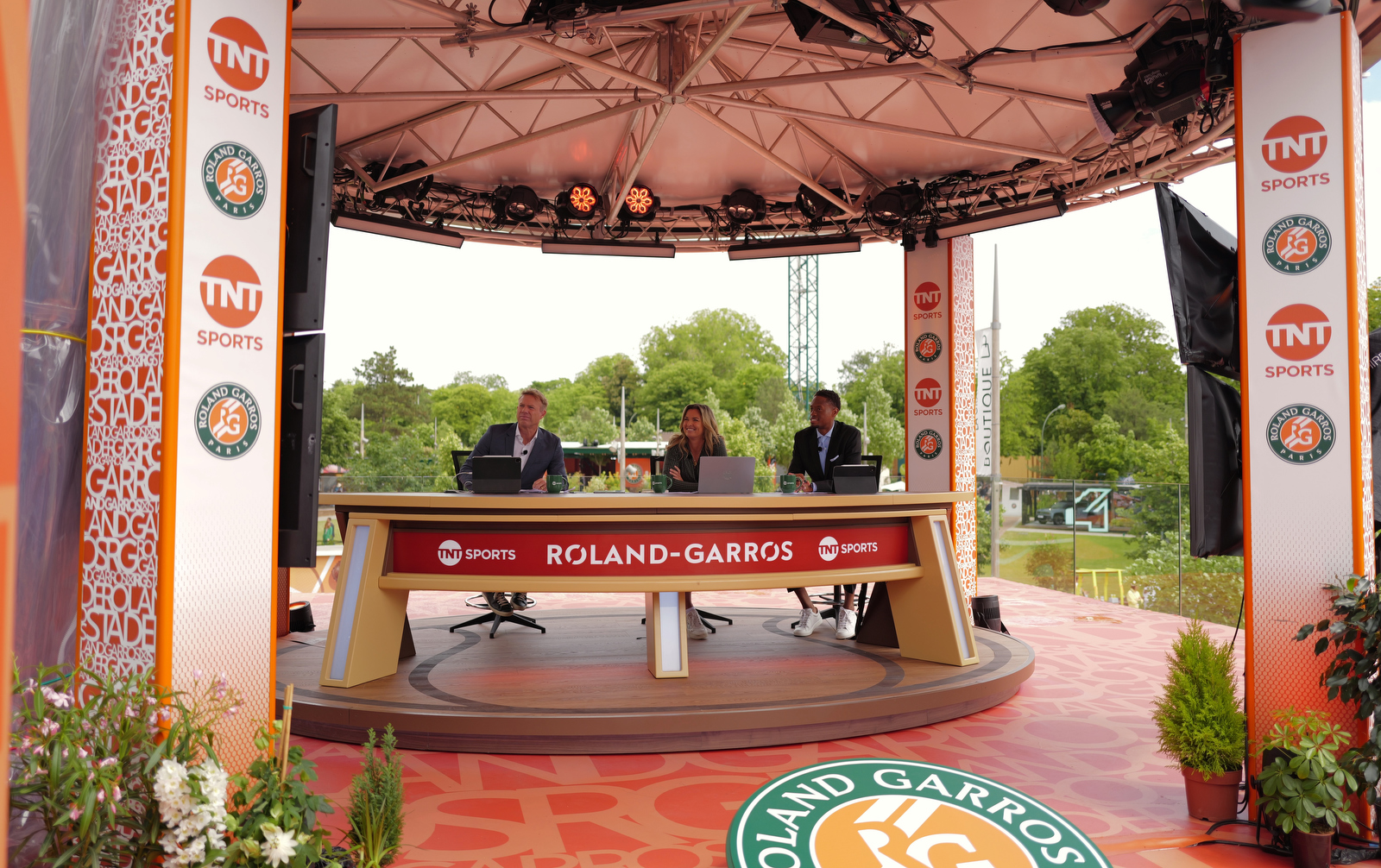
TNT Sports studio at Roland Garros. Photos courtesy of TNT Sports.
“The passion that this fan base has for tennis, especially the home tennis players, it’s unlike any of the four majors,” Fiorello said. “Being in the middle of that with our studio show is gonna really be something special for us.”
Sharing space with European counterpart Eurosport, the studio space presented unique construction challenges due to trees and light poles within the footprint.
Shorthouse said the team went multiple rounds of revisions and iterations before finding a workable solution. The final design incorporates the natural elements, with glass panels that can be removed in good weather to integrate the studio with the surrounding fan zone.
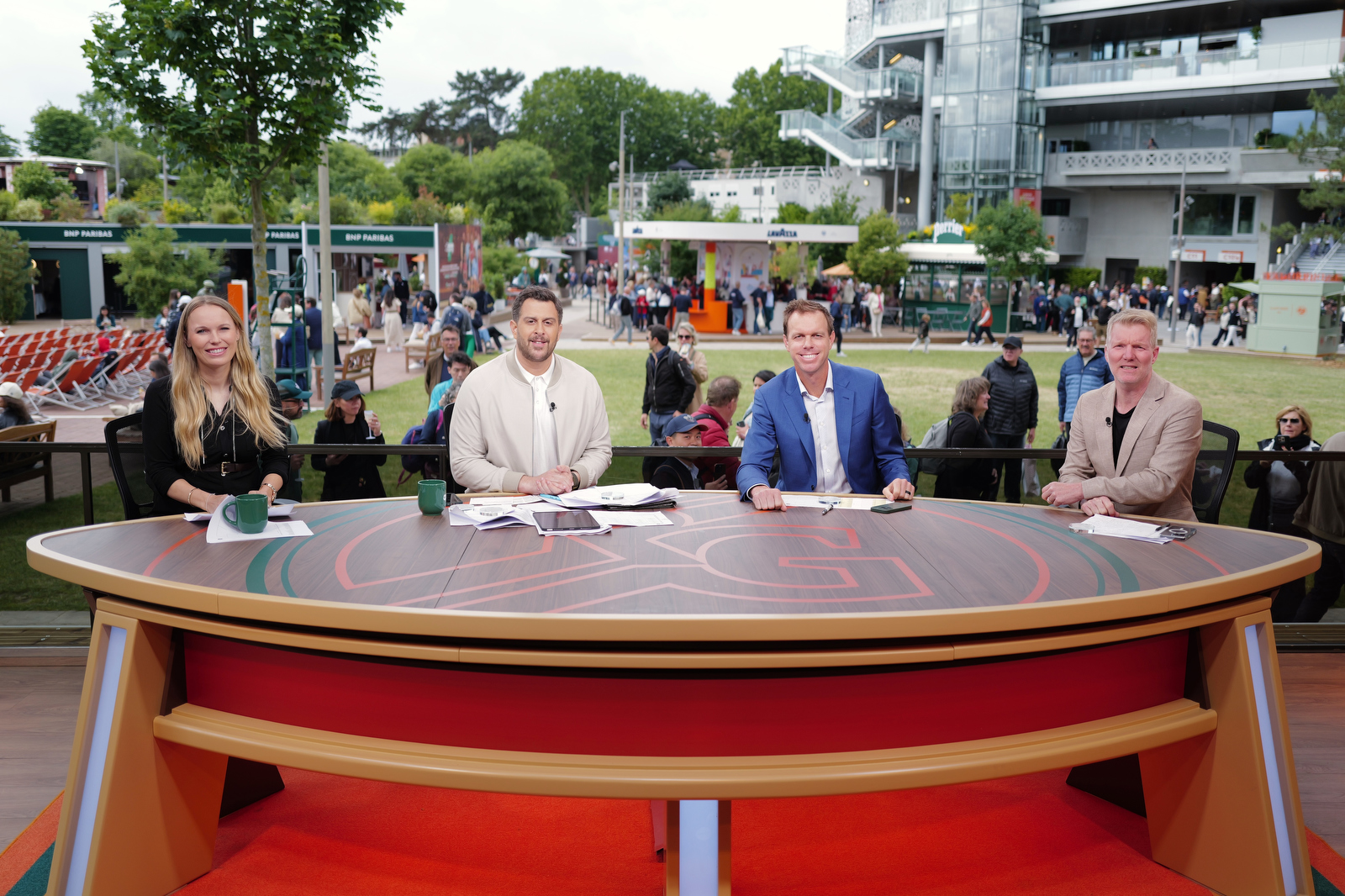
The integrated studio features a central desk, a stand-up area with a sizable LED screen along with a movable LED wall backdrop in the studio. A 30-foot jib outside the studio further enriches atmosphere and scenic coverage.
Graphics balance sophistication with energy
Shorthouse’s team worked with Toronto-based Big Studios to develop motion graphics that reflect both Parisian sophistication and tennis’ fast-paced nature.
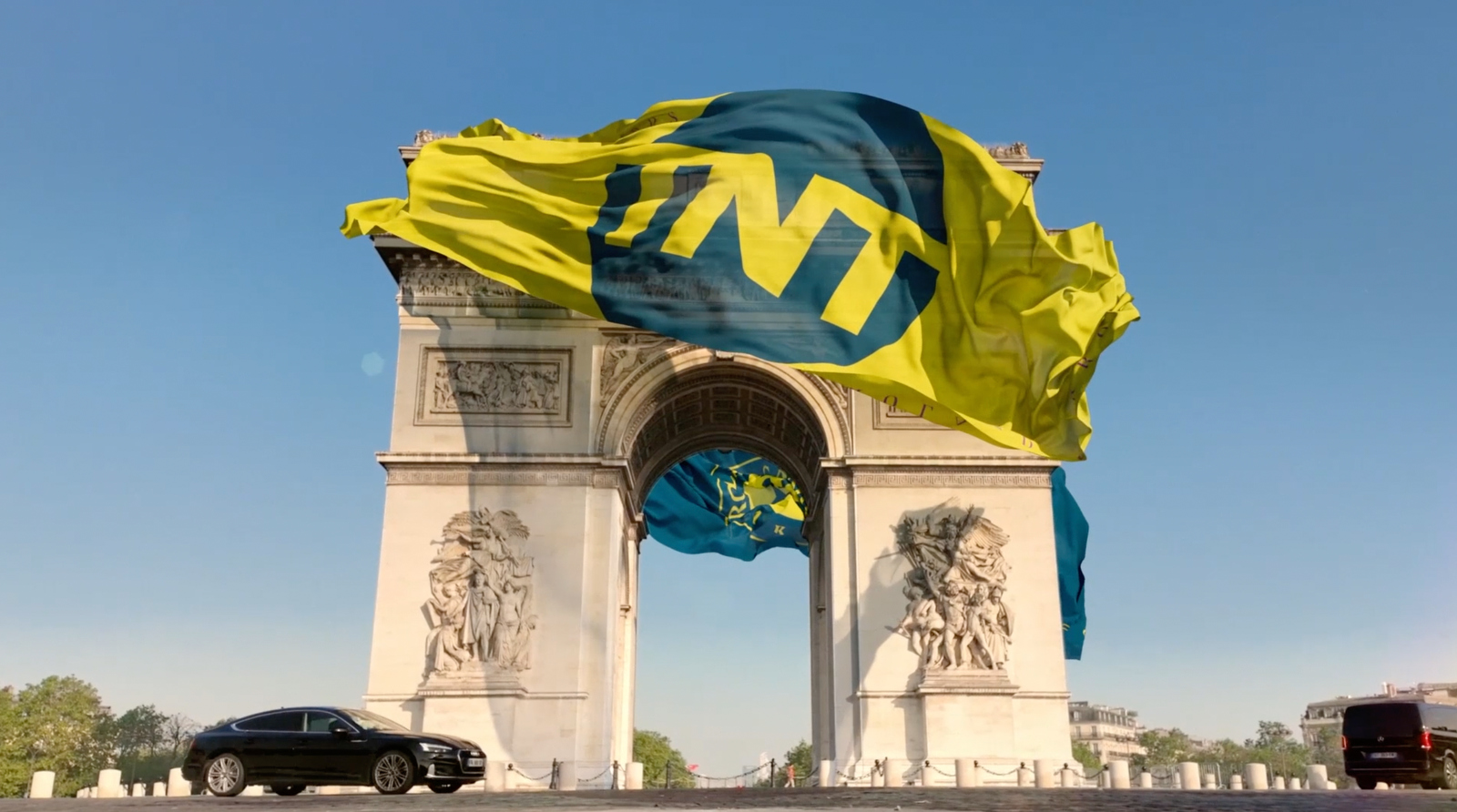

The package incorporates scenic elements including the Eiffel Tower and Roland Garros artwork while maintaining what Shorthouse describes as “clean, sophisticated design styles.”
“We wanted to make sure that it was sophisticated and matched the culture of Roland Garros and the sophistication of the sport and the tournament,” Shorthouse said, while also emphasizing the package still had to feel like TNT Sports.
“We leaned into the Rolling Garros style guide, but then we also broke out of it in times and added splashes of other colors just to add a vibrancy to it,” said Shorthouse.
The graphics utilize a rich color palettes, mixing yellows and oranges – both nods to tennis balls and the clay courts – with clean whites and vibrant purples and blues. The approach deliberately avoids what Shorthouse termed a “stagnant and royal” feeling in favor of something “more fun and creative.”

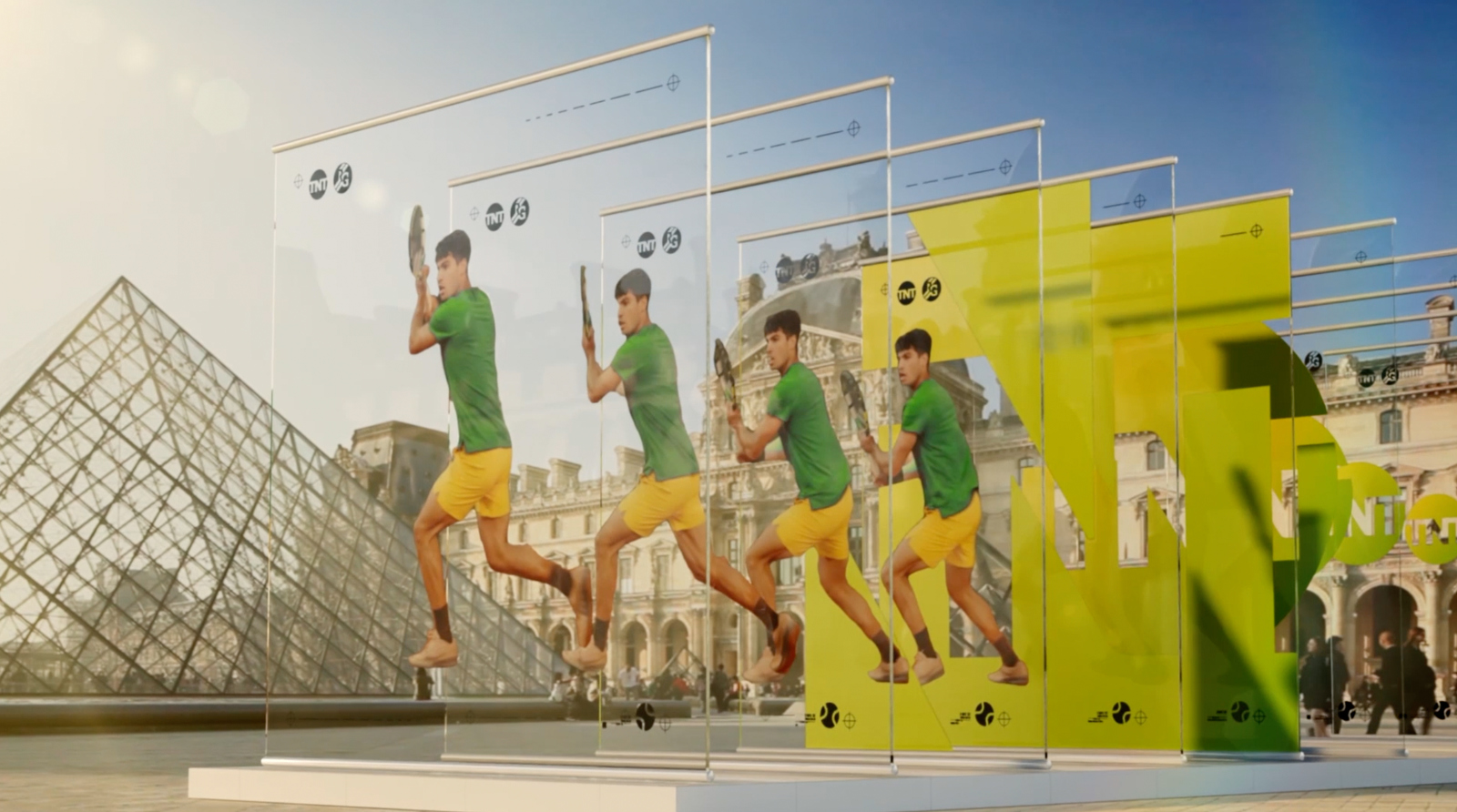
The package incorporates glass frames as repeating elements representing tennis ball motion with clouds of dust from fast clay court action. The design mixes polished 3D renders of the Roland Garros logo and tennis paraphernalia with imagery from around Paris.
“The end result was a package that leans into some scenics like the Eiffel Tower and also some of the art around Roland Garros,” Shorthouse explained.
The graphics extend across linear and digital productions, with SMT providing automated scoring for streaming coverage of qualifying matches, ensuring consistent TNT Sports branding across all platforms.
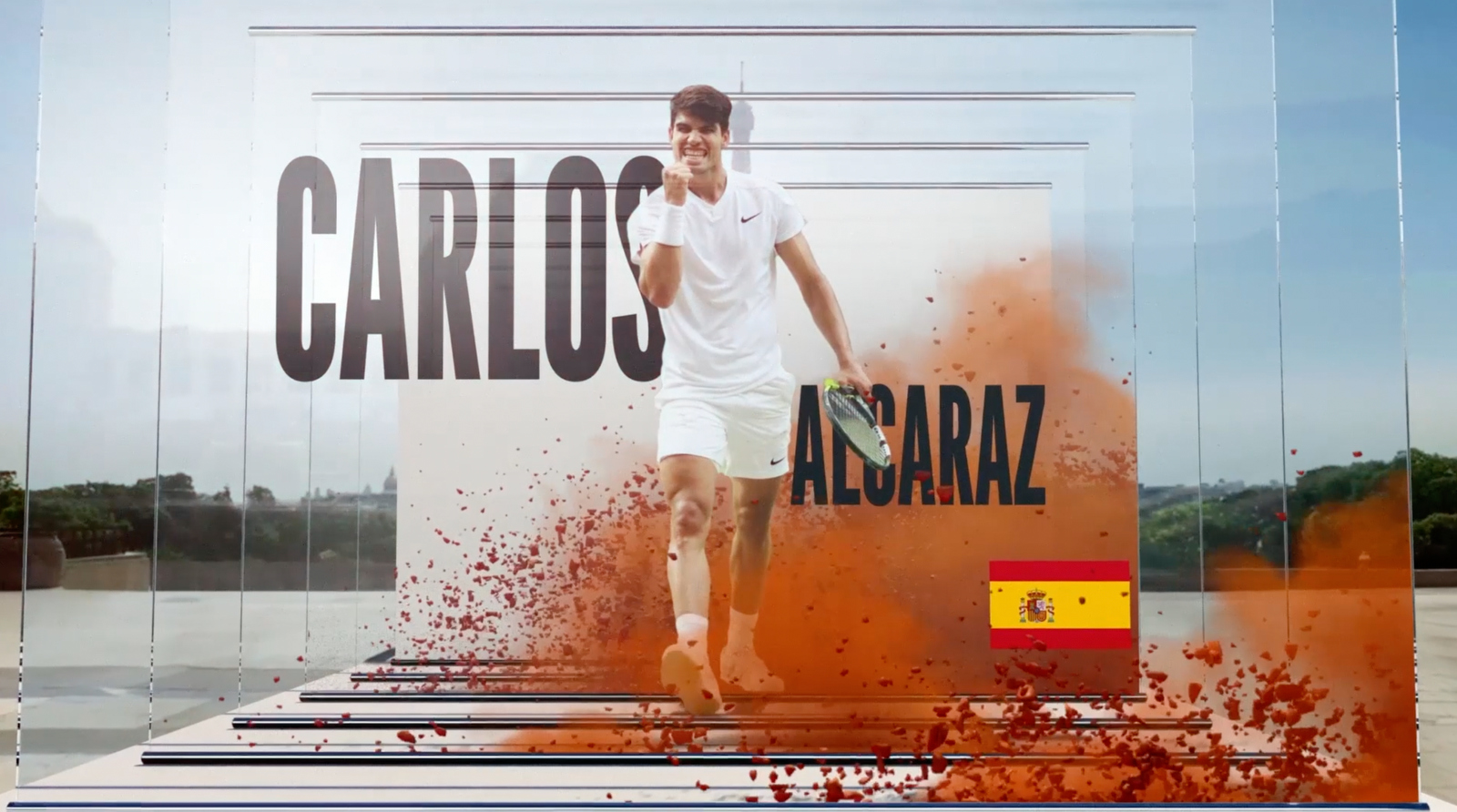
Adding another graphical layer, TNT Sports constructed detailed 3D models of the entire Roland Garros grounds with Black Shark technology, powered by Pixotope with rendering in Unreal Engine.
“We can use it as a way to transition from court to court,” Shorthouse explained. “You can go to any court and show any matchup at any time. And it’s all real, live, real-time renders.”
The virtual environment serves multiple storytelling functions beyond court transitions. Augmented reality graphics can layer into studio coverage or highlight various courts, providing content options during weather delays and enhancing match analysis capabilities.
Musically, Mark Willott composed a custom theme for the coverage with Michael Doherty providing orchestration and Four For Music providing the live orchestra. The theme mixes a driving rhythm with a powerful horn section, creating a memorable broadcast opening that feels at home for tennis while matching the energy of TNT’s broadcast.
Breaking tennis broadcasting conventions
TNT Sports secured FFT approval for innovations that challenge established norms in tennis broadcasting. The network is conducting live interviews with coaches during matches, unprecedented at any major tournament, with coaches wearing microphones to speak with commentators during play.
“Getting the opportunity to get a coach to wear a microphone and talk to our booth during the match is a very unique experience for viewers,” Fiorello said, noting the effort aims at modernizing tennis broadcasting to provide greater access and storytelling opportunities.
The innovation reflects TNT Sports’ broader approach to tennis coverage, which involves applying interactive techniques common in other sports to a traditionally more formal broadcast environment.
All the technology and innovation serve a fundamental goal of providing a compelling broadcast while maintaining the sport’s inherent sophistication. The network’s coverage works to strike a careful balance between accessibility and reverence that tennis requires.
“Our approach is always to compliment the sport. Compliment the sport, be credible, and have fun. And that was our approach here,” Shorthouse said.
Subscribe to NCS for the latest news, project case studies and product announcements in broadcast technology, creative design and engineering delivered to your inbox.




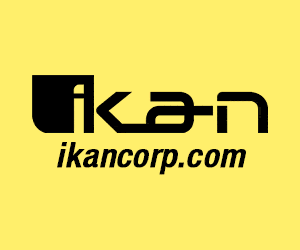

tags
Big Studios, Calrec, Calrec Artemis, Chris Brown, EMG/Gravity Media, eurosport, EVS, EVS Cerebrum, French Open, Globecast, Grass Valley, HBO Max, Jordan Shorthouse, Kayenne K-Frame Video Production Center, Mark Willott, max, NEP Specialty Capture, Roland Garros, Ross Video, Ross Xpression, smt, Sony Hawk-Eye Replay, Steve Fiorello, tennis, TNT, TNT Sports, truTV, turner sports, XPression
categories
Branding, Graphics, Heroes, Set Design, Sports Broadcasting & Production, Sports Set Design